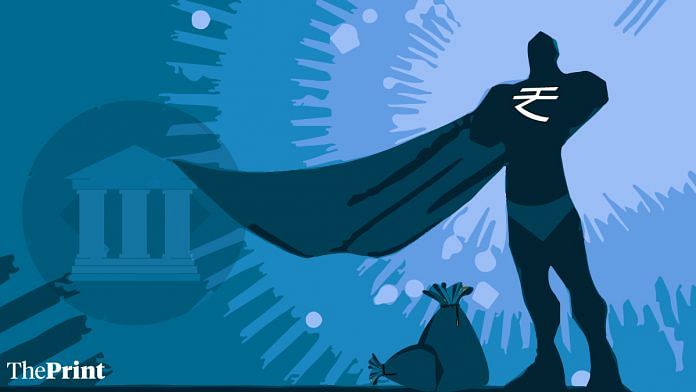From being Asia’s worst performing currency, Indian rupee turned on its head just weeks before 2019 elections to become the best and further appreciated after Narendra Modi and his BJP’s landslide victory. And yet, analysts seem divided over the prospects of the Indian rupee (currently trading at 69 and above to a dollar), even as it seems poised for more depreciation based on widening trade deficit and rising oil prices.
ThePrint asks: Is the Indian rupee overvalued?
Compared to other economies, India’s exchange rate has been more or less stable with slight appreciation
 Radhika Pandey
Radhika Pandey
Economist, NIPFP
The overall merchandise exports growth fell sharply to 0.64% in April 2019. This has triggered debate on whether the Indian rupee is overvalued. The flat growth in exports in April was preceded by a double digit growth of 11% in March.
The assessment about the fair value of the Indian rupee, thus, cannot be based on one month’s reading. The wider used measure: The Real Effective Exchange Rate does show an appreciating trend from 94.6 in October 2018 to 99.61 in April 2019.
Also, if we compare the trajectory of the rupee-dollar exchange rate with other similarly placed economies, Indian exchange rate has remained more or less stable with slight appreciation.
However, the dynamics affecting exports run much deeper than whether the domestic currency is overvalued or undervalued. Exports are influenced by domestic competitiveness and world demand. Commentaries by the WTO suggest that global trade growth is going to remain slow in 2019 and 2020 due to trade tensions and economic uncertainty.
Domestically, the liberalisation in the norms governing foreign investment in debt including relaxation of the norms governing the Voluntary Retention Route could result in significant inflows of foreign funds resulting in an upward pressure on the rupee.
Views are personal.
Currency valuation model should be used as analytical or directional tool rather than as exact science
 Anubhuti Sahay
Anubhuti Sahay
Senior Economist, Standard Chartered Bank
Is Indian rupee overvalued and, if yes, to what extent? The answer to this would crucially depend on the metric picked and subsequent adjustments made to it. For instance, Standard Chartered Bank-Real Effective Exchange Rate of 36 currencies (similar to the Reserve Bank of India 36-currencies REER) at 118.2 in May 2019 indicates an overvaluation of currency — 5 per cent — assuming its last 10-year average as the fair value.
REER is a weighted average of nominal exchange rates adjusted for inflation differential with its trading partners. However, if one adjusts for productivity differential (assuming productivity differential similar to 2014 as latest data is unavailable), overvaluation of Indian rupee estimates is smaller. To conclude, even as the Indian rupee seems overvalued, its accurate quantification can be challenging.
Hence, experts opine that REER or any other currency valuation model should be used as analytical or directional tool rather than as exact science. We believe that the Indian rupee is overvalued and therefore target INR at 70 against a dollar by the end of 2019. Portfolio inflows since positive election outcome can pick up but we think the RBI will likely aim to rebuild its FX reserves position. Separately, the weakness in regional currencies amid re-emergence of US-China trade tensions can also limit any strengthening in INR. From a medium-term perspective, given that India remains a current account deficit economy, the Indian rupee is likely to stay weak.
Valuation of sovereign currencies is often determined in terms of ‘relative pricing’ to ‘stronger’ currencies
 Deepanshu Mohan
Deepanshu Mohan
Assistant Professor of Economics, OP Jindal Global University
India requires a competitive currency. For this, any base currency comparison of the rupee with another market needs to be carefully weighed in proportion to currency markets where our competition is (in both, commodity and capital goods).
Under/over-valuation of sovereign currencies often remains determined in terms of their ‘relative pricing’ to other ‘stronger’ currencies (example, INR to USD). For emerging economies like India targeting for greater export-competitiveness, not only does one need to compare their relative price of goods and services, but complimentarily, need to ensure a competitive currency ‘price’ (or value) in relation to other exporting-markets, too.
The Indian rupee has remained ‘over-valued’ to other commodity export markets — especially across regional exporting zones — where nations like Bangladesh, China, Vietnam have gained from a ‘cheaper’ real currency valuation. This gradual over-valuation of rupee is a consequence of skewed macro-economic focus on increasing foreign capital account mobility, and an increase in foreign investment demand saw its value to rise.
An appropriate rupee pricing mechanism at this point may require the current valuation to be maintained (without risking for higher inflationary spirals from any conscious devaluation) under a pre-identified float (range) and keep it monitored vis-à-vis other competing markets. For a competitive rupee, expanding the regional export base is critical, which further requires a push to resolve existing supply-side bottlenecks across agri-business and manufacturing export segments.
Use of Real Effective Exchange Rate to assess the strength of the currency has its limitations
 Prerna Prabhakar
Prerna Prabhakar
Associate Fellow, National Council of Applied Economic Research
India rupee valuation is often characterised by wide-ranging perspectives. After hitting a low of 74.34 against the dollar in October 2018, Indian rupee started showing signs of strengthening. A significant contributor to this trend has been the international crude oil prices that touched a mark of 80 dollar per barrel in October 2018 and exhibited a reversal in this surging trend thereafter, which got reflected in the increasing value of rupee.
The rupee appreciation with respect to dollar is consistent with Real Effective Exchange Rate (REER), which is measured as a weighted average of India’s bilateral real exchange rates with all the 36 countries in the basket. As per the theory, extent of over valuation in rupee is gauged by magnitude of REER, with respect to a baseline figure of 100 – the larger the gap between baseline and REER, higher is the degree of over valuation. And as per the current trend in REER, rupee is substantially overvalued, with a value of 117.81 in April 2019.
However, use of REER to assess the strength of the currency has its limitations due to number of issues like the method of assigning weights to different trading partners in the basket. For an accurate view on valuation of rupee, it is imperative to track the trend in crude oil prices, which seem to have again reversed since January 2019 and climbed up to 71.2 dollar per barrel in April 2019. If this crude oil price hike continues, it is expected to put downward pressure on Indian rupee. Against these recent trends, view with regard over valuation of Indian rupee cannot be considered conclusive.
Also read: No agreement on which way rupee is headed as election exuberance fizzles out
More than the rupee’s valuation, what is crucial is the extent of volatility the currency witnesses
 Remya Nair
Remya Nair
Senior associate editor, ThePrint
The Indian rupee has been steadily appreciating for the last few weeks after falling to an all-time low of 74 per dollar in October last year. With rupee trading around 69 to a dollar, economists are divided over whether these levels indicate that the rupee is overvalued when compared to other currencies.
The Indian rupee’s levels are indicative of the strength of the Indian economy and the confidence of foreign investors in the Indian market and not by any excessive intervention from the Reserve Bank of India. The RBI has always maintained that it steps in only to contain extreme volatility and not to change the movement of the rupee.
More than the rupee’s levels vis a vis the dollar, what is crucial is the extent of volatility the currency witnesses. Volatility remains a crucial concern for all market participants, including the RBI, especially at a time uncertainty prevails globally. The fallout from curbing oil imports from Iran as well as the fallout of the US-China trade war will impact India’s current account deficit and consequently the rupee.
It will not take rupee a long time to start depreciating again if the global scenario worsens further.
By Fatima Khan, journalist at ThePrint.







REER is for Trade but a Currency’s strength or weakness affects the Citizens also.This REER is NOT the basis to decide whether a Currency is strong or weak from a national perspective.India’s Rupee is weak and will continue to be so,till we reduce our imports and start exporting without weakening the Rupee thus cheapening ourselves and subsidizing our Foreign Customers.For this we should stop our pro-US Dollar policy [which weakens the Rupee] and anti-Gold policy.Gold inverse US Dollar.Hence India should stop being anti-Gold.The Rupee at present is very weak.India being an essentially importing Nation,she should has to have a very strong Rupee,comparatively.
I was studying in St Xavier’s Delhi when Mrs Gandhi depreciated it from 5 to 7.50 to the USD. Dr Singh gave it a one – two punch in 1991. We have seen it continue to weaken. Just a mater of time before it becomes worth one cent. Whatever else this may have done, it has not given exports a boost. Makes imports more expensive, feeds into inflation. Adds to the burden of corporates that borrow abroad, unavoidable for a capital deficient nation. If the debate is part of the effort to increase export competitiveness, I don’t think this is the solution.